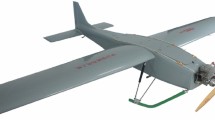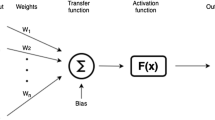Abstract
The complicated formation flight for multi-unmanned aerial vehicles is a challenge, especially when multi-mission requirements are taken into account. This paper studies the adaptive differential evolution-based distributed model predictive control approach to deal with the multi-unmanned aerial vehicle flight achieving obstacle/collision avoidance and formation keeping simultaneously in the complex environment. Specifically, the distributed model predictive controller is designed to achieve stable flight for each unmanned aerial vehicle as well as taking the state and input saturation into account, where the local optimization problem is solved by the adaptive differential evolution algorithm. Besides, the adaptive adjustment to the prediction horizon for the model predictive controller is introduced, while the asymptotic convergence of the rolling optimization is analyzed as well. Finally, simulation examples are provided to illustrate the validity of the proposed control structure.










Similar content being viewed by others
References
Pack DJ, DeLima P, Toussaint GJ et al (2009) Cooperative control of UAVs for localization of intermittently emitting mobile targets. IEEE Trans Syst Man Cybern Part B Cybern 39(4):959–970
Nigam N, Bieniawski S, Kroo I et al (2012) Control of multiple UAVs for persistent surveillance: algorithm and flight test results. IEEE Trans Control Syst Technol 20(5):1236–1251
Han J, Xu Y, Di L, Chen YQ (2013) Low-cost multi-UAV technologies for contour mapping of nuclear radiation field. J Intell Rob Syst 70(1–4):401–410
Ousingsawat J, Campbell ME (2007) Optimal cooperative reconnaissance using multiple vehicles. J Guidance Control Dyn 30(1):122–132
Meng W, He Z, Su R et al (2017) Decentralized multi-UAV flight autonomy for moving convoys search and track. IEEE Trans Control Syst Technol 25(4):1480–1487
Zhang JL, Yan JG, Zhang P et al (2018) Collision avoidance in fixed-wing UAV formation flight based on a consensus control algorithm. IEEE Access 6:43672–43682
Hafez AT, Marasco AJ, Givigi SN et al (2015) Solving multi-UAV dynamic encirclement via model predictive control. IEEE Trans Control Syst Technol 23(6):2251–2265
Hu JL, Sun XX, He L (2019) Time-Varying formation tracking for multiple UAVs with nonholonomic constraints and input quantization via adaptive backstepping control. Int J Aeronaut Sp Sci. https://doi.org/10.1007/s42405-019-00157-6
Yu ZQ, Qu YH, Zhang YM (2018) Distributed fault-tolerant cooperative control for multi-UAVs under actuator fault and input saturation. IEEE Trans Control Syst Technol. https://doi.org/10.1109/TCST.2018.2868038
Zhang JL, Yan JG, Zhang P (2018) Fixed-Wing UAV formation control design with collision avoidance based on an improved artificial potential field. IEEE Access 6:78342–78351
Li P, Qin KY, Pu HP (2017) Distributed robust time-varying formation control for multiple unmanned aerial vehicles systems with time-delay. In: Chinese control and decision conference, Chongqing, China, pp 1539–1544
Hu CF, Zhang ZL, Yang N et al (2019) Fuzzy multiobjective cooperative surveillance of multiple UAVs based on distributed predictive control for unknown ground moving target in urban environment. Aerosp Sci Technol 84:329–338
Cai ZH, Zhao J, Wu K et al (2018) Formation control of multiple unmanned aerial vehicles by event-triggered distributed model predictive control. IEEE Access 6:55614–55627
Ahmed F, Deb K (2013) Multi-objective optimal path planning using elitist non-dominated sorting genetic algorithms. Soft Comput 17(7):1283–1299
Karimi J, Pourtakdoust SH (2013) Optimal maneuver-based motion planning over terrain and threats using a dynamic hybrid PSO algorithm. Aerosp Sci Technol 26(1):60–71
Zhu WR, Duan HB (2014) Chaotic predator–prey biogeography-based optimization approach for UCAV path planning. Aerosp Sci Technol 32(1):153–161
Storn K (1995) Price, “Differential evolution-a simple and efficient adaptive scheme for global optimization over continuous spaces. Technical Report, International Computer Science Institute, Berkeley, CA
Mao Y, Niu SX, Yang Y (2018) Differential evolution-based multiobjective optimization of the electrical continuously variable transmission system. IEEE Trans Ind Electron 65(3):2080–2089
Wang Y, Liu H, Long H et al (2018) Differential evolution with a new encoding mechanism for optimizing wind farm layout. IEEE Trans Ind Inf 14(3):1040–1054
Zhang XY, Duan HB (2012) Differential evolution-based receding horizon control design for multi-UAVs formation reconfiguration. Trans Inst Meas Control 34(2/3):165–183
Zhang XY, Duan HB, Yu YX (2010) Receding horizon control for multi-UAVs close formation control based on differential evolution. Sci China Inf Sci 53(2):223–235
Wang JN, Xin M (2013) Integrated optimal formation control of multiple unmanned aerial vehicles. IEEE Trans Control Syst Technol 21(5):1731–1744
Lin YC, Chen DD, Chen MS et al (2018) A precise BP neural network-based online model predictive control strategy for die forging hydraulic press machine. Neural Comput Appl 29(9):585–596
Yao P, Wang HL, Su ZK (2015) Real-time path planning of unmanned aerial vehicle for target tracking and obstacle avoidance in complex dynamic environment. Aerosp Sci Technol 47:269–279
Patan K (2015) Neural network-based model predictive control: fault tolerance and stability. IEEE Trans Control Syst Technol 23(3):1147–1155
Cortes OAC, Chaplin AR, Wilson D, et al (2014) On PBIL, DE and PSO for optimization of reinsurance contracts. In: European conference on the applications of evolutionary computation, Granada, Spain, pp 227–238
Lin LJ, Zhu M (2018) Efficient tracking of moving target based on an improved fast differential evolution algorithm. IEEE Access 6:6820–6828
Knobloch R, Mlynek J, Srb R (2017) The classic differential evolution algorithm and its convergence properties. Appl Math 62(2):197–208
Xu YJ (2009) Nonlinear robust stochastic control for unmanned aerial vehicles. J Guidance Control Dyn 32(4):1308–1319
Izadi AH, Zhang Y, Gordon BW (2011) Fault tolerant model predictive control of quad-rotor helicopters with actuator fault estimation. The International Federation of Automatic Control World Congress, Milano, pp 6343–6348
Yao P, Wang H, Ji H (2016) Multi-UAV tracking target in urban environment by model predictive control and improved grey wolf optimizer. Aerosp Sci Technol 55:131–143
Na HJ, Yoo S (2019) PSO-Based dynamic UAV positioning algorithm for sensing information acquisition in wireless sensor networks. IEEE Access 7:77499–77513
Acknowledgements
The authors gratefully acknowledge the support of Aeronautical Science Foundation of China under Grant no. 20155896025.
Author information
Authors and Affiliations
Corresponding author
Ethics declarations
Conflict of interest
The authors declare that there are no conflicts of interest regarding the publication of this paper.
Additional information
Publisher's Note
Springer Nature remains neutral with regard to jurisdictional claims in published maps and institutional affiliations.
Rights and permissions
About this article
Cite this article
Zhang, B., Sun, X., Liu, S. et al. Adaptive Differential Evolution-Based Distributed Model Predictive Control for Multi-UAV Formation Flight. Int. J. Aeronaut. Space Sci. 21, 538–548 (2020). https://doi.org/10.1007/s42405-019-00228-8
Received:
Revised:
Accepted:
Published:
Issue Date:
DOI: https://doi.org/10.1007/s42405-019-00228-8




